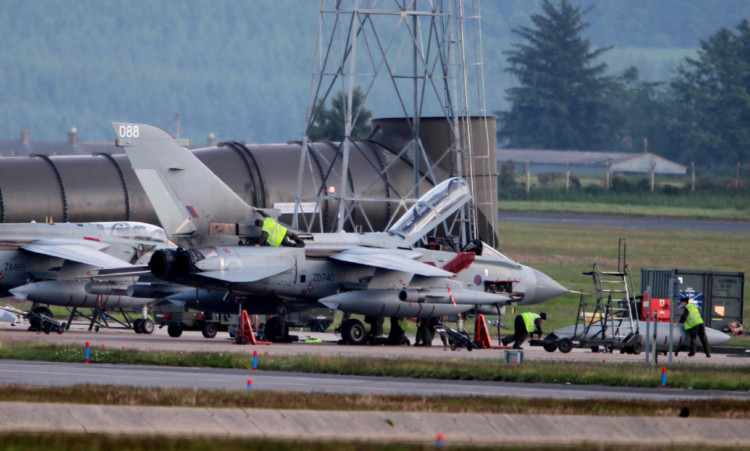A trivia question for you: what flies at 1,000 miles per hour, costs between £20 and £100 million, has a catastrophic risk of collision with a commercial airliner but does not have the technology to prevent it?
You guessed yet? Fast jets. Military aircraft without the basic collision warning systems you would find on your budget Ryanair or EasyJet summer flight to Spain.
Some 10 days ago, the long-awaited publication of the Military Aviation Authority’s (MAA) report into the fatal collision in July 2012 involving RAF Tornados over the Moray Firth was published.
The accident killed three airmen, with a fourth seriously injured, from RAF Lossiemouth.
In case you missed it, it found a collision warning system could have prevented this tragic accident a system that has been tested and recommended for the Tornado for more than 20 years.
The 300-page report is particularly critical of the processes within the MoD, which meant procurement of a collision warning system for the Tornado fleet was repeatedly delayed, deferred and, at one point, deleted. The Government issued a statement last week, accepting liability for the 2012 Tornado collision.
Speaking in a Fast Jets Commons adjournment debate called by SNP MP Angus Robertson on Tuesday, the minister for defence equipment, support and technology, Philip Dunne, answered questions on the report. What he went on to say was, no doubt, a shock to air safety campaigners.
He confirmed there is no timetable or known cost for installing a collision warning system on Typhoon fast jets and that, after years of delay, a system was currently being tested on the planes. This is obviously welcome, but there is not currently a planned solution for the more modern Typhoon jets.
Mr Robertson, the SNP defence spokesperson whose constituency includes RAF Lossiemouth, said a series of negligent decisions by the MoD may have led to the deaths and there is an overwhelming public interest case for a fatal accident inquiry.
Why do we need a collision warning system? The risk of mid-air collision is significant. Official statistics from the UK Airprox Board show that, between 1998 and 2013, there were 361 airprox events involving Tornado jets.
We also recently learned of a near miss at Leuchars where a passenger plane had to bank sharply to avoid being hit by a Typhoon. Even the service inquiry report cites “the catastrophic risk of collision with a commercial airline”.
So why have they not been installed? The inquiry reported that the need for a collision warning system was known within the Ministry of Defence 24 years ago, following a collision in 1990.
We know there was an extensive collision warning system development programme between the early 90s and the late 90s, which the MoD was committed to but to this day has not been fully delivered.
At the time, secretary of state for Defence George Robertson did not declare the funding to be non-discretionary; therefore spending on this life-saving technology was not protected and the project could be delayed again and again.
In 2005 the Tornado Collision Warning System Initial Gate Business Case estimated nine Tornados and five civilian aircraft would be lost before the plane was retired from service if it was not installed. Then, in the same year, the MoD defers the collision warning system, keeping up a charade that there was funding in place for 2010, knowing it could only be installed for 2014.
We then have the defence secretary of the day, Liam Fox, cancelling the collision warning system, only to reinstate it three months later, in 2011. This is a total shambles that is likely to have resulted in the loss of lives, and continues to threaten the loss of more.
In the House of Commons Philip Dunne defended his failure to implement a collision warning system, saying: “The service inquiry specifically stated ‘it is not possible to completely remove the risk of colliding with another aircraft, regardless of the controls and mitigation put in place.
Therefore, a collision warning system is not a panacea it cannot guarantee a mid-air collision would not happen again. What it does provide is an additional level of security and another tool for the air crew to use.”
So while a collision warning system cannot guarantee collisions will be avoided, it can sure as hell help toward preventing one.
The report highlights comments by the Director General of the Military Aviation Authority about the fact that although Tornados will be out of service soon, it is “unlikely to be accepted as compensation for the apparent failure of the Dept to implement the programme hitherto herein lies the very significant ‘societal risk’ that the Department is viewed publicly as having been derelict in its duty of care to both its personnel and the public at large.”
Clearly, there are still many questions on this issue that remain unanswered.
The best way for this to be done, and to help secure a timetable for the installation of a collision warning system, is to hold a fatal accident inquiry. It is time for the MoD to be under oath and under pressure.
We owe it to the future safety of RAF personnel, civilian air-traffic and communities under the flight paths of RAF fast jets.
